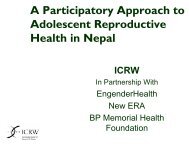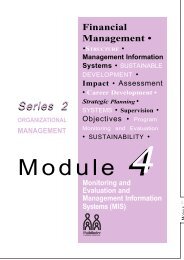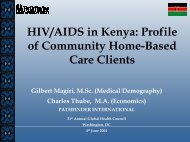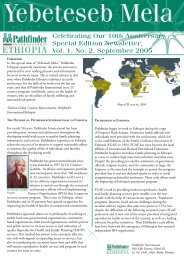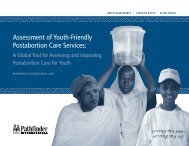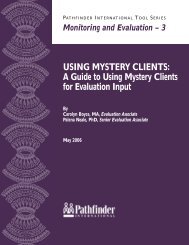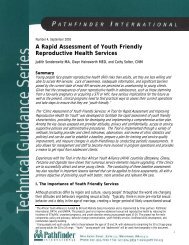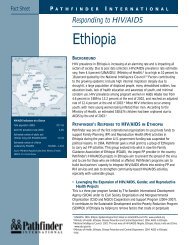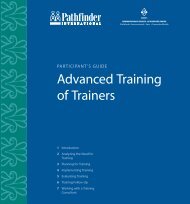reproductive health services for adolescents - Pathfinder International
reproductive health services for adolescents - Pathfinder International
reproductive health services for adolescents - Pathfinder International
You also want an ePaper? Increase the reach of your titles
YUMPU automatically turns print PDFs into web optimized ePapers that Google loves.
Module 16/Unit 4<br />
CONTENT<br />
Knowledge/Attitudes/Skills<br />
Training/Learning Methods<br />
(Time Required)<br />
• Rein<strong>for</strong>cing the decision to seek<br />
counseling and/or <strong>health</strong> care <strong>for</strong> felt<br />
concerns.<br />
• Expressing non-judgmental views<br />
about the client’s needs and<br />
concerns.<br />
• Demonstrating responsibility <strong>for</strong><br />
fulfilling one’s professional role in<br />
assisting the adolescent client.<br />
• Exhibiting confidence and<br />
professional competence in<br />
addressing ARH issues.<br />
VERBAL/NONVERBAL<br />
COMMUNICATION<br />
Health care providers need to explore<br />
the many different nonverbal and<br />
verbal behaviors they use when<br />
communicating with clients.<br />
Sometimes, without realizing it, providers<br />
communicate one message verbally,<br />
while communicating the opposite<br />
message nonverbally.<br />
Nonverbal communication is a<br />
complex and often unconscious mixture<br />
of actions, behaviors, and feelings that<br />
reveal the way we really feel about<br />
something.<br />
Nonverbal communication is especially<br />
important because it communicates<br />
to clients the level of interest,<br />
attention, warmth, and understanding<br />
we feel towards them.<br />
Positive nonverbal cues include:<br />
• Leaning toward the client.<br />
VERBAL/NONVERBAL<br />
COMMUNICATION EXERCISE (30 MIN.)<br />
The trainer should:<br />
• Ask the Px to <strong>for</strong>m pairs.<br />
• One person should talk <strong>for</strong> 5 minutes<br />
about a personal problem or concern.<br />
• The other should try to communicate<br />
interest, understanding, and help in<br />
any way s/he wishes nonverbally<br />
(s/he may not speak).<br />
• Have the pairs switch roles and<br />
repeat the exercise <strong>for</strong> 5 minutes.<br />
• Stop and allow 2 to 3 minutes <strong>for</strong> the<br />
pairs to talk freely to each other.<br />
• Discuss the exercise with the entire<br />
group. Some questions to raise are:<br />
How did it feel to talk <strong>for</strong> five<br />
uninterrupted minutes<br />
How did it feel to be prevented<br />
from talking<br />
<strong>Pathfinder</strong> <strong>International</strong><br />
50<br />
Adolescent Curriculum



